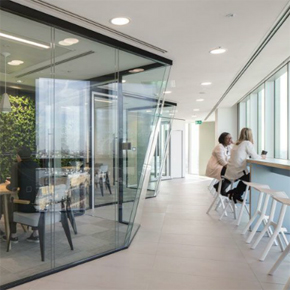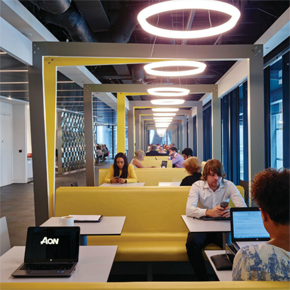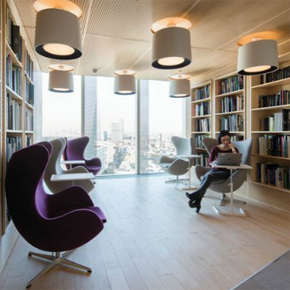
Workable workplaces: Addressing the design demands of the modern office
In the August issue of ABC&D Magazine, Philippe Paré, principal design director at Gensler, discusses the demands of the modern office and the benefits of personality-driven design…
In the workplace today, more than ever before, there is a strong correlation between employee performance and the workplace environment. Designers and architects have shifted their focus to creating an environment adaptable to differing personality types, resulting in a more productive and efficient workplace.
Designers should work with employees who are looking to make this change to create a vision for their workplace that will, ultimately, improve workplace performance and productivity.
Activity-based and personality-driven design
Gensler provides environments that allow individuals to accelerate, increase collaboration and do the best work they possibly can; in other words, by creating places that play to people’s strengths, it fundamentally builds a high-performance work environment.
Activity-based models are now the norm. Designers and architects have paid attention to exploring how different personality types can be productive in distinct working environments, and creating areas that can be applicable to both introvert and extrovert personalities.
This means that people are given a choice to work in the setting that best suits the task at hand.
Subsequently, if an individual is more extroverted, there is the choice to sit in an exposed environment whereas, for the more introvert characters, there will also be the option for more focused booths that will allow them to have their own space, ensuring they get the uninterrupted peace and quiet they require.
Creating individual spaces
 Another design attribute is the ability to move to different work settings; the ability for individuals to modify their work environment.
Another design attribute is the ability to move to different work settings; the ability for individuals to modify their work environment.
In Gensler’s own office, there are panels on wheels, which can be moved and changed to create close-knit working spaces or large collaborative spaces. The advantage of this is that it provides the ability to create individual spaces, whatever the environment required.
This creates spaces that are not so defined. By paying attention to spaces that have an unscripted quality, and using a kit of moveable parts-and-pieces to make it suit the task at hand, means the workplace becomes extremely flexible and adaptable.
Emphasis on wellbeing
Previously, spaces have been defined by the function they support. However, with the rise of the trend around wellbeing, we are now really starting to place users at the front and centre.
The ability to create spaces is what actually starts to challenge the notion that they have to be based on function only. It is also about setting a mood or an emotion that spaces can elicit or support.
Some people may think that a flexible, personality-centric model is suited to some companies more than others. However, the truth is (although we must be cautious of generalising) there are no obvious setbacks for any individual company to take on this approach, regardless of the industry they are in.
Preparing for the future workforce
This shift in workplace environments reflects wider business and workforce trends, and will support companies in preparing for the future.
 Recent research has shown that one in two workers in the UK will be freelancers by 2030. A greater number of companies are looking to hire based on project, meaning that we need to think differently about what the permanent workplace is.
Recent research has shown that one in two workers in the UK will be freelancers by 2030. A greater number of companies are looking to hire based on project, meaning that we need to think differently about what the permanent workplace is.
Businesses will need to accommodate fluctuations in the workforce, anticipate five or ten years ahead where, often, sudden increases and decreases in employees based on projects may take place. This idea, again, echoes the need for the workplace to become much more flexible.
The only way this can successfully happen is by accommodating permanent employees and externals, and making the latter feel they are part of the company. This creates challenges in terms of confidentiality and security – and at the same time, it is necessary to consider how you allow freelancers to be comfortable and feel part of a business. These sorts of issues are likely to transform and change workplaces.
Essentially, what we are seeing happening right now is activity-based workplace design. The open plan will evolve – we are still at a point where we are just now realising its limitations.
As we transition into more personality-driven parameters, we are starting to realise the importance of scale; providing environments that are open but also accommodating of people who want to retrench and create their own, defined spaces.
Read more in the August issue of ABC&D Magazine
Latest news

21st February 2025
ASSA ABLOY EMEIA: Save valuable time and money with a seamless switch to programmable digital keys
In 2025, access management can be a whole lot easier. By making access part of their digital processes, businesses can put time-consuming key management and the cost of changing the locks firmly behind them. Making this switch is a lot easier than many people think, as ASSA ABLOY explains here…
Posted in Access Control & Door Entry Systems, Architectural Ironmongery, Articles, Building Industry News, Building Products & Structures, Building Services, Doors, Facility Management & Building Services, Health & Safety, Information Technology, Innovations & New Products, Retrofit & Renovation, Security and Fire Protection
21st February 2025
Showersave supports industry leaders in addressing Part L and Part G regulations
Showersave has sponsored and participated in a recent Building Insights LIVE roundtable on ‘Water & Energy Saving Innovations in New Build Housing’.
Posted in Articles, Bathrooms & Toilets, Bathrooms, Bedrooms & Washrooms, Building Associations & Institutes, Building Industry Events, Building Industry News, Building Products & Structures, Building Regulations & Accreditations, Building Services, Exhibitions and Conferences, Interiors, Pipes & Fittings, Plumbing, Retrofit & Renovation, Sustainability & Energy Efficiency
21st February 2025
GEZE: The importance of Specifying High Quality Door Closers on Fire Doors
Andy Howland, Sales & Marketing Director at GEZE UK, discusses why specifying high quality door closers on fire doors is important…
Posted in Access Control & Door Entry Systems, Accessibility, Architectural Ironmongery, Articles, Building Industry News, Building Products & Structures, Building Regulations & Accreditations, Building Services, Doors, Facility Management & Building Services, Health & Safety, Posts, Restoration & Refurbishment, Retrofit & Renovation, Security and Fire Protection
21st February 2025
Insight Data achieves ISO9001 recertification with zero non-conformities
Leading industry data specialist, Insight Data, has successfully achieved the prestigious recertification for ISO9001 with zero non-conformities for the fourth consecutive year.
Posted in Articles, Building Industry News, Building Regulations & Accreditations, Building Services, Information Technology, Research & Materials Testing
 Sign up:
Sign up: